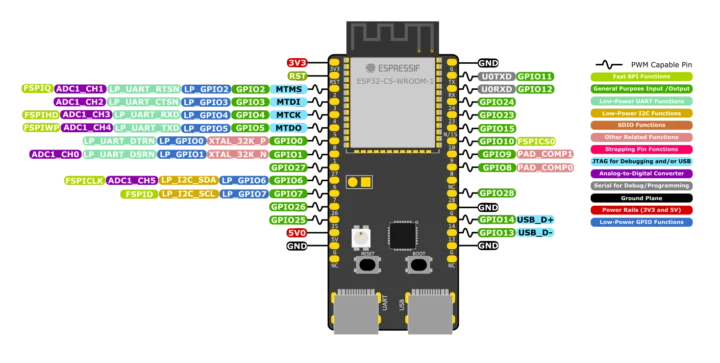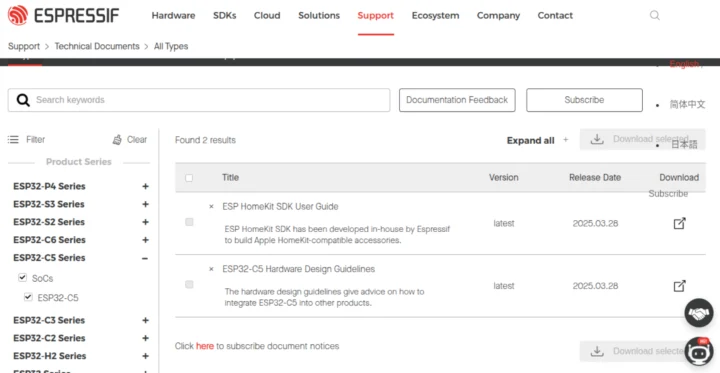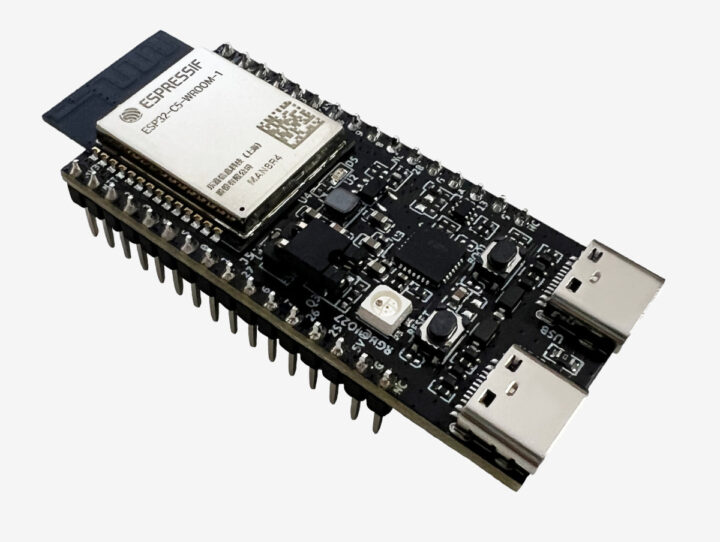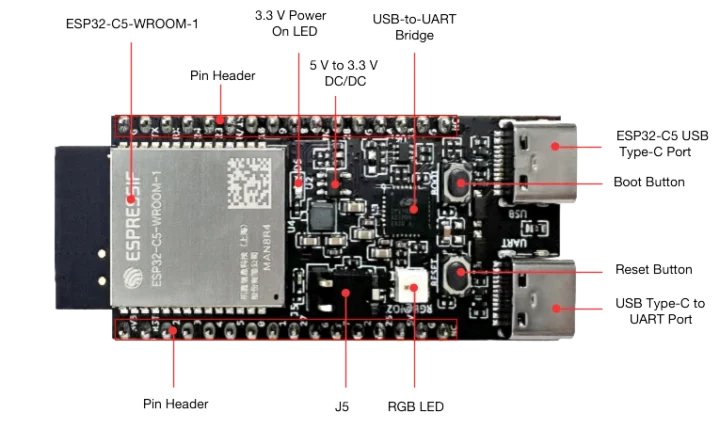Espressif Systems has just started mass production of the ESP32-C5 RISC-V wireless microcontroller with dual-band (2.4/5 GHz) WiFi 6, Bluetooth LE, and 802.15.4 (Zigbee, Thread) connectivity. The ESP32-C5-DevKitC-1 development is now available for about $15 on AliExpress, and should soon show up on the company’s Amazon store.
So far, WiFi-capable Espressif microcontrollers have only supported 2.4 GHz WiFi since it’s cheaper and offers better range for IoT applications, but some applications may benefit from 5 GHz WiFi, so the company unveiled the ESP32-C5 dual-band WiFi 6 and BLE RISC-V MCU in June 2022. Design probably took longer than expected, but we noted documentation for an ESP32-C5 beta board in March 2024, and finally, the company has just announced that mass production has started. We’ll have a closer look at the ESP32-C5-DevKitC-1 board in this article, since it is different from the beta board.
ESP32-C5-DevKitC-1 specifications:
- Wireless module – ESP32-C5-WROOM-1
- SoC – ESP32-C5
- CPU
- Single-core 32-bit RISC-V processor @ up to 240 MHz
- Low-power RISC-V core @ 40 MHz acting as the main processor for power-sensitive applications
- Memory – 384 KB SRAM on-chip, support for external PSRAM
- Storage – 320 KB ROM, support for external flash
- Connectivity
- Dual-band 802.11ax WiFi 6 in the 2.4GHz and 5 GHz bands, with 802.11b/g/n WiFi 4 standard support for backward compatibility
- 20MHz bandwidth for the 802.11ax mode
- 20/40MHz bandwidth for the 802.11b/g/n mode
- OFDMA (Orthogonal Frequency Division Multiple Access) mechanism for both uplink and downlink
- MU-MIMO capability for downlink
- Target Wake Time (TWT) support allows devices to sleep for an extended time period (important for battery life)
- Bluetooth 5.0 Low Energy (LE)
- 802.15.4 radio for Zigbee 3.0 and Thread 1.3
- Dual-band 802.11ax WiFi 6 in the 2.4GHz and 5 GHz bands, with 802.11b/g/n WiFi 4 standard support for backward compatibility
- CPU
- Memory – 8MB PSRAM
- Storage – 4MB SPI flash
- PCB antenna
- SoC – ESP32-C5
- USB
- USB Type-C port – USB 2.0 full speed up to 12 Mbps (480 Mbps high-speed transfer mode is not supported). Used to power the board, flash applications to the chip, communicate with the chip using USB protocols, as well as for JTAG debugging.
- USB Type-C to UART port – Used to power the board and flash the application to the chip; up to 3 Mbps baudrate.
- Expansion – 2x 16-pin GPIO headers with all I/Os except SPI (used by the flash) – See pinout diagram below
- Misc
- Power LED (3.3V)
- RGB LED driven by GPIO27
- Boot and Reset buttons
- J5 jumper for current measurement
- Power Supply
- 5V via either USB-C ports or 5V and GND pins
- 3.3V via 3V3 and GND pins
- 5V to 3.3V DC/DC switching regulator
- Dimensions – 51.8 x 25.5 mm

The ESP32-C5-DevKitC-1 is more or less the same as the ESP32-C6-DevKitC-1 board, except it relies on an ESP32-C6-WROOM-1 module with dual-band WiFi 6. The ESP32-C5 SoC, WROOM modules, and devkit will be officially supported in the upcoming ESP-IDF v5.5. Arduino support will likely take a few more months. You can find instructions on the documentation page. The ESP32-C5 can also be used as a wireless coprocessor connected to a host microcontroller or application processor using ESP-AT or ESP-Hosted.
While the ESP32-C5-DevKitC-1 board can be purchased directly on Aliexpress, you would need to contact Espressif Systems sales to get the samples of the ESP32-C5 SoC, the ESP32-C5-WROOM-1 module, or the upcoming ESP32-C5-MINI-1U module with an external antenna. More details may be found on the product page, but note that I was unable to find the datasheet, and public documentation is limited. The website will probably be updated soon.


Jean-Luc started CNX Software in 2010 as a part-time endeavor, before quitting his job as a software engineering manager, and starting to write daily news, and reviews full time later in 2011.
Support CNX Software! Donate via cryptocurrencies, become a Patron on Patreon, or purchase goods on Amazon or Aliexpress. We also use affiliate links in articles to earn commissions if you make a purchase after clicking on those links.





Can this now do Thread/Zigbee and Wifi at the same time whitout multiplexing?
This is a great question, and we have a definitive answer straight from the proverbial horse’s mouth: NO. 😔
See here:
https://docs.espressif.com/projects/esp-faq/en/latest/software-framework/wifi.html#does-esp32-c5-support-simultaneous-use-of-2-4ghz-and-5ghz-wi-fi
The C5 continues to have only one RF path, in spite of having an additional 5GHz antenna.
Pitty, so they just seem to use one radio and swap the freq
Espressif is mainly in the end device market. Other companies are in the router market and they offer multi-radio solutions.
The vendor-recommended approach to non-multiplexed, simultaneous use of WiFi + [something else] remains using two physically connected chips, interfaced through one of their software solutions. You *can* of course manage the comms between the chips yourself, but then you lose the benefit of automatic interference management/compensation, which Espressif’s first-party solutions provide out of the box.
• For simultaneous WiFi + Bluetooth using two chips, the recommended software stacks are ESP-AT, ESP-Hosted, or ESP-Extconn.
• For simultaneous WiFi + Thread using two chips, the recommended software stack is ESP-THREAD-BR.
• For simultaneous WiFi + Zigbee using two chips, I’m not aware of a turn-key solution, but ESP-IDF provides Zigbee libraries, and it shouldn’t be too hard to whip up a function on the dedicated WiFi chip that relays Zigbee traffic through the dedicated Zigbee chip.
Of course, the layout of the chips (and their antennas) has to be considered as well, since Zigbee/Thread/Bluetooth and classic WiFi are all on the same 2.4GHz band.
Hello. Did you check NXP RW612? There are variants of the development board supporting separate antennas for WiFi and BLE/Thread. The FRDM board by default has a single antenna, but variants like the RD BGA or 3rd party modules from Murata seem to have separate RF front ends.
The ESP32-C5 datasheet (pre-release v0.5) is now available: https://www.espressif.com/sites/default/files/documentation/esp32-c5_datasheet_en.pdf